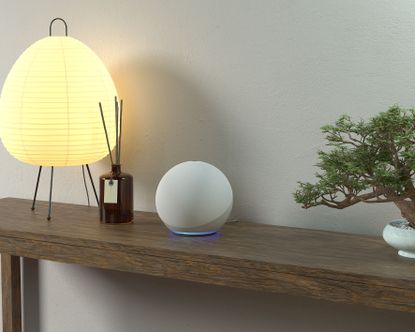What is Alexa Together? We review the feature families can use to share care for older and vulnerable people
Alexa Together is a remote caregiving service with Amazon’s virtual assistant, but how does it work, and is it worth it?


The responsibility of looking after ageing relatives is just a part of life, yet it's one that, arguably, hasn't kept up with advances in technology across the board.
Amazon's idea, Alexa Together, is looking to change this, applying technical solutions to an age-old problem using existing Alexa compatible devices. Alexa Together can help to share care responsibilities for older and vulnerable people, and keep everyone in the picture, without infringing on your loved-ones privacy. Here's how it works.
What is Alexa Together?
As the name suggests, Amazon’s virtual AI assistant Alexa is a key part of the company’s solution. It’s a subscription service that allows you and up to nine others to share a vulnerable friend or relative’s Alexa account, letting you keep tabs on what's happening in their homes, even if separated by hundreds of miles.
As well as introducing new Alexa skills alerting you to their general movements and routine so you can spot anything out of the ordinary, Alexa Together includes a dedicated 24/7 Urgent Response team, who can call emergency services if necessary.
Currently, it’s only available in the United States.
How much does it cost?
Alexa Together is a subscription service which costs $19.99 per month or $199 per year, plus any applicable taxes.
But that’s just the service cost. You’ll need at least one Echo, the cheapest of which available new is the third-generation Echo Dot (MSRP $40) but to get the full benefit of dropping in for video calls, you’ll need an Echo Show for both you and your loved one (between $85 and $250 depending on size). Note that Amazon is constantly discounting its products, especially around the holiday season, so it shouldn’t cost anywhere near this much if you’re savvy.
If you want fall detection alerts, you’ll need a compatible device. These include the $170 ATS SkyAngelCare pendant and a couple of $250 wall-mounted sensors.
How does Alexa Together work?
The main way Alexa Together works is by letting you and up to nine other people have access to a vulnerable person’s Alexa account.
There are a few advantages to this. The first is that you can get a (very generalized) view of how they’re interacting with Alexa over the course of a day. This won’t tell you exactly what they’re up to for privacy reasons, but it will reassure you that they’re up and about, whether they’re using their Echo to listen to music, check the weather or turning on issuing smart home commands.
Cleverly, you can also make the absence of activity something to look out for, with the Alexa app letting you receive a notification with the opportunity to drop in on their Echo for a check-in chat if no activity is detected at expected hours.
Those are the passive peace-of-mind perks, but you can also use Alexa Together to make a proactive difference in the lives of the owner. With Remote Assist, you or another helper can assist from your own home, setting reminders to take pills, or adding items to shopping lists, for example.

The thing that really commands the premium price is the 24/7 Urgent Response team. If the owner is in trouble at any point, they can simply say “Alexa, call for help” and a nearby Echo will instantly connect them to trained agents who can offer assistance, no matter what the emergency.
They could call 911, of course, but Alexa can’t do that, and this offers a hands-free way of getting instant assistance. It will also send helpers a notification and let them know when the call is complete so they can drop in on their Echo to find out what’s happened.
Finally, there’s fall detection. Unlike the other features, this needs something else — one of a handful of supported devices from Vayyar, SkyAngelCare or AltumView. If these connected devices detect trouble, they will call the aforementioned Urgent Response team without further intervention, getting help for more serious accidents where the owner can’t call for help with their voice.
Any drawbacks?
The main issue with Alexa Together is that it needs the person being monitored’s willingness to engage with the virtual assistant — something that is by no means guaranteed. If the friend or relative can’t or won’t engage with Alexa, then much of the peace of mind is lost, as you can’t see that they’re up and about.
Fortunately, the month’s free trial should give you enough time to figure out whether it is for you, though that does of course require at least one Echo device. Plus, to get the most out of it, you need extra smart home devices to get a full picture of the person’s life — something that is rather handy to Amazon’s overall aim of selling products. Indeed, you probably want an Echo in most rooms, just so they can always be heard if they need to say “Alexa, call for help.”
On the note of extras, for fall detection to work, you’ll need to buy a compatible wearable and these can be pricey, ranging from $170 for a pendant to $250 for a camera sensor. The latter is only useful for one room, so the cost can easily spiral.
It’s also worth remembering that these fall alerts require the owner to be in range of the Echo — if they’re in the garden, at the shops or otherwise away then Alexa won’t be letting you know anything’s wrong. Equally, because Echos don’t have a cellular connection, if the WiFi goes down, then you’ll also be left out of the loop.
Still, the thing to remember with these negatives is that Alexa Together, at $19.99 per month or $199 per year (plus tax), is far cheaper than true dedicated medical alert systems. And a flawed solution is arguably better than nothing.
Final thoughts
Alexa Together is certainly an interesting proposition, and a (relatively) cheap way for families to stay in touch with distant relatives, even if geography separates them.
But despite Amazon’s efforts to make Alexa intuitive, it’s still not for everyone, and Alexa Together relies on the vulnerable individual embracing the slightly odd 21st century world of an always-listening device in their home. Not everyone will be.
Still, if you have ageing relatives who are open to the idea of smart-home life, and you can afford the monthly cost, then at the very least it’s worth signing up for the free trial. Worst case scenario: you’ll be taking advantage of Amazon’s 30-day return policy on the Echo.
Be The First To Know
The Livingetc newsletter is your shortcut to the now and the next in home design. Subscribe today to receive a stunning free 200-page book of the best homes from around the world.
Freelance contributor Alan has been writing about tech for over a decade, covering phones, drones and everything in between. Previously Deputy Editor of tech site Alphr, his words are found all over the web and in the occasional magazine too. He often writes for T3 and Tom's Guide. When not weighing up the pros and cons of the latest smartwatch, you'll probably find him tackling his ever-growing games backlog. Or, more likely, playing Spelunky for the millionth time.
-
 The 12 Best Table Lamps for Reading —I'm a Certified Bookworm (and Shopping Expert)
The 12 Best Table Lamps for Reading —I'm a Certified Bookworm (and Shopping Expert)When it comes to table lamps for reading, I don't mess around. If you're the same, this edit is for YOU (and your books, or course — and good recommendations?)
By Brigid Kennedy Published
-
 "It's Scandi Meets Californian-Cool" — The New Anthro Collab With Katie Hodges Hits Just the Right Style Note
"It's Scandi Meets Californian-Cool" — The New Anthro Collab With Katie Hodges Hits Just the Right Style NoteThe LA-based interior designer merges coastal cool with Scandinavian simplicity for a delightfully lived-in collection of elevated home furnishings
By Julia Demer Published

